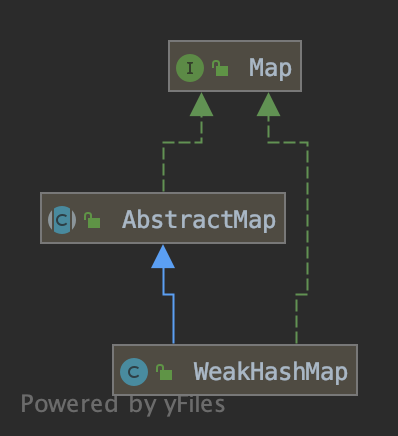简介
基于哈希表的Map接口的实现,带有弱键。当集合中的键没有引用时,将会被垃圾回收器删除。
类继承关系

属性
/**
* 默认初始容量-必须为2的幂。
*/
private static final int DEFAULT_INITIAL_CAPACITY = 16;
/**
* 最大容量
*/
private static final int MAXIMUM_CAPACITY = 1 << 30;
/**
* 默认加载因子
*/
private static final float DEFAULT_LOAD_FACTOR = 0.75f;
/**
* hash槽
*/
Entry<K,V>[] table;
/**
* 键值对的数量
*/
private int size;
/**
* 下次扩容的阈值
*/
private int threshold;
/**
* 加载因子
*/
private final float loadFactor;
/**
* 已清除虚键的队列
*/
private final ReferenceQueue<Object> queue = new ReferenceQueue<>();
/**
* 用来表示null键
*/
private static final Object NULL_KEY = new Object();
内部类
// 继承了WeakReference 说明这个键是个虚键
// 并且实现了Entry节点 可以作为单链表
private static class Entry<K,V> extends WeakReference<Object> implements Map.Entry<K,V> {
V value;
final int hash;
Entry<K,V> next;
/**
* 内部节点值得注意的是这个构造方法
* super(key, queue)调用父类构造 传入key和引用队列
* 当GC回收了key的时候 会将这个Entry放到队列里面 就像是个回调
* 这边发现队列有数据 就去清理一下(清理节点,key已经回收了)
*/
Entry(Object key, V value, ReferenceQueue<Object> queue,
int hash, Entry<K,V> next) {
super(key, queue);
this.value = value;
this.hash = hash;
this.next = next;
}
}
构造
//构造一个空map,拥有默认的初始容量16,和加载因子0.75
public WeakHashMap() {
this(DEFAULT_INITIAL_CAPACITY, DEFAULT_LOAD_FACTOR);
}
public WeakHashMap(int initialCapacity) {
this(initialCapacity, DEFAULT_LOAD_FACTOR);
}
public WeakHashMap(int initialCapacity, float loadFactor) {
if (initialCapacity < 0)
throw new IllegalArgumentException("Illegal Initial Capacity: "+
initialCapacity);
if (initialCapacity > MAXIMUM_CAPACITY)
initialCapacity = MAXIMUM_CAPACITY;
if (loadFactor <= 0 || Float.isNaN(loadFactor))
throw new IllegalArgumentException("Illegal Load factor: "+ loadFactor);
//确定初始容量 寻找大于传入容量的最近 2的幂
//这里循环判断是否大于初始容量 不大于 在翻一倍 直到找到那个数
//注意这里算法和HashMap不一样 但是功能是一样的
int capacity = 1;
while (capacity < initialCapacity)
capacity <<= 1;
table = newTable(capacity);
this.loadFactor = loadFactor;
threshold = (int)(capacity * loadFactor);
}
hash
final int hash(Object k) {
int h = k.hashCode();
// 此函数可确保在每个位位置仅
//常数倍相差的hashCode具有
//有限的冲突次数(默认负载因子约为8)
h ^= (h >>> 20) ^ (h >>> 12);
return h ^ (h >>> 7) ^ (h >>> 4);
}
插入put
public V put(K key, V value) {
Object k = maskNull(key);//如果key=null 使用默认全局nullKey表示
int h = hash(k);
Entry<K,V>[] tab = getTable();//获得table 这个函数里面先清除了一遍GC后的数据
int i = indexFor(h, tab.length);//h & (length-1) 定位hash槽
for (Entry<K,V> e = tab[i]; e != null; e = e.next) {
if (h == e.hash && eq(k, e.get())) {//如果已经插入 更新值
V oldValue = e.value;
if (value != oldValue)
e.value = value;
return oldValue;
}
}
//没有插入过 那么就插入啦
modCount++;
Entry<K,V> e = tab[i];//找到要插入位置的节点 要将它变为自己的尾节点 采用头插法
tab[i] = new Entry<>(k, value, queue, h, e);
if (++size >= threshold)//如果数量到达阈值 就扩容一倍
resize(tab.length * 2);
return null;
}
private static Object maskNull(Object key) {
return (key == null) ? NULL_KEY : key;
}
获取get
public V get(Object key) {
Object k = maskNull(key);
int h = hash(k);//计算hash码
Entry<K,V>[] tab = getTable();//获取表
int index = indexFor(h, tab.length);//定位 和插入规则一样
Entry<K,V> e = tab[index];//找到所在hash槽 时间复杂度O(1)
while (e != null) {
if (e.hash == h && eq(k, e.get()))
return e.value;
e = e.next;
}
return null;
}
移除remove
public V remove(Object key) {
//老规矩 计算hash码 获取tab表 定位hash槽
Object k = maskNull(key);
int h = hash(k);
Entry<K,V>[] tab = getTable();
int i = indexFor(h, tab.length);
Entry<K,V> prev = tab[i];//第一个节点
Entry<K,V> e = prev;
while (e != null) {
Entry<K,V> next = e.next;
if (h == e.hash && eq(k, e.get())) {//找到节点后
modCount++;
size--;
//如果要删除的节点是第一个 那么直接把下一个节点放到hash槽就行了
//否则将第一个节点指向下一个节点
if (prev == e)
tab[i] = next;
else
prev.next = next;
return e.value;
}
prev = e;
e = next;
}
return null;
}
扩容resize
void resize(int newCapacity) {
Entry<K,V>[] oldTable = getTable();
int oldCapacity = oldTable.length;
if (oldCapacity == MAXIMUM_CAPACITY) {
threshold = Integer.MAX_VALUE;
return;
}
Entry<K,V>[] newTable = newTable(newCapacity);
transfer(oldTable, newTable);
table = newTable;
/*
* If ignoring null elements and processing ref queue caused massive
* shrinkage, then restore old table. This should be rare, but avoids
* unbounded expansion of garbage-filled tables.
*/
if (size >= threshold / 2) {
threshold = (int)(newCapacity * loadFactor);
} else {
expungeStaleEntries();
transfer(newTable, oldTable);
table = oldTable;
}
}
移除被GC的节点expungeStaleEntries
private void expungeStaleEntries() {
for (Object x; (x = queue.poll()) != null; ) {
synchronized (queue) {
@SuppressWarnings("unchecked")
Entry<K,V> e = (Entry<K,V>) x;
int i = indexFor(e.hash, table.length);
Entry<K,V> prev = table[i];
Entry<K,V> p = prev;
while (p != null) {
Entry<K,V> next = p.next;
if (p == e) {
if (prev == e)
table[i] = next;
else
prev.next = next;
// Must not null out e.next;
// stale entries may be in use by a HashIterator
e.value = null; // Help GC
size--;
break;
}
prev = p;
p = next;
}
}
}
}